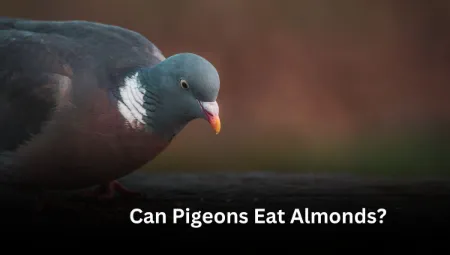15 Yellow Birds With Black Wings to Discover
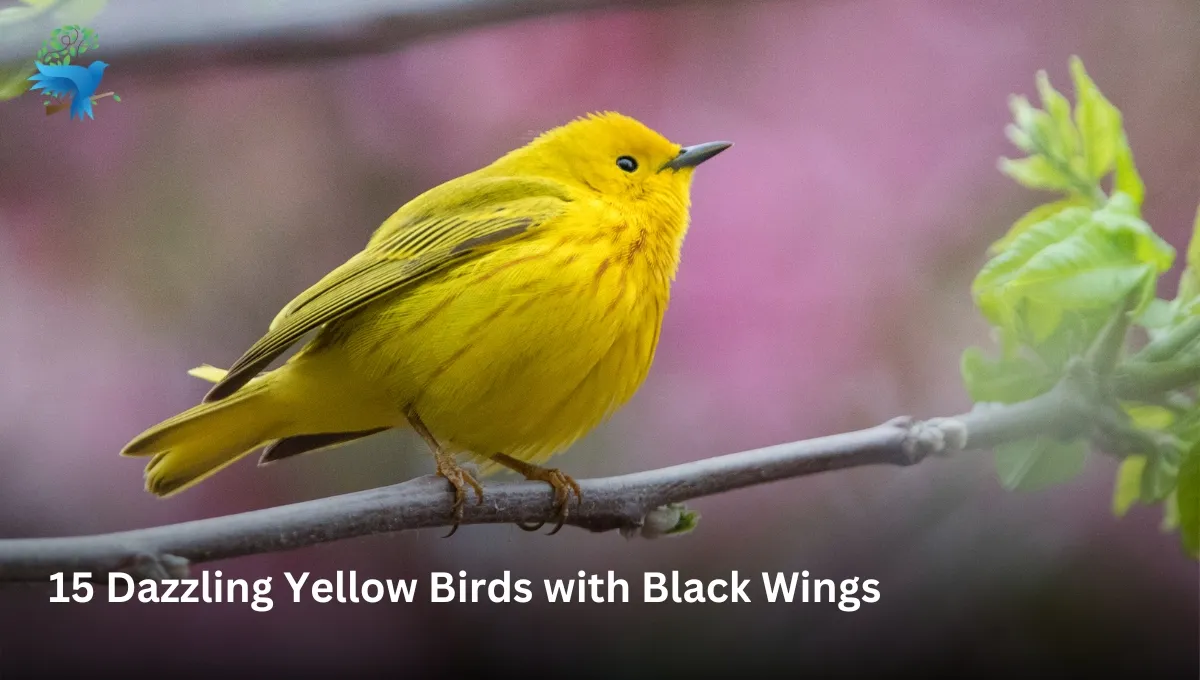
Birds, with their vibrant hues, bring a delightful splash of color to our world. Among them, yellow birds, with their sunny shades, are a source of joy. These feathered creatures become even more striking when they display their contrasting black wings.
Let’s explore the fascinating realm of the bird kingdom, where the colors yellow and black come together in a stunning display.
15 Yellow Birds with Black Wings to Discover
1. Yellow-headed Blackbird
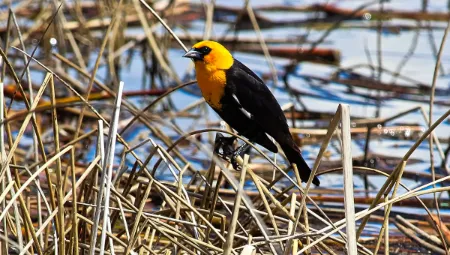
Where to find Yellow-headed Blackbird
The yellow-headed Blackbird is native to North America and primarily resides in freshwater marshes with tall, dense vegetation like cattails and bulrushes. During the summer, they migrate to the west-central area of the United States and Canada.
In the winter, they can be found from Texas to California, and also in Mexico. They are strongly territorial during the breeding season and like to nest in marches above water that is two to four feet deep.
Short Description of Yellow-headed Blackbird
The Yellow-headed Blackbird, a medium-sized bird, is known for its distinctive yellow head and sleek black body.
Size of the Bird
- Length: 8.3-10.2 in(21-26 cm)
- Wingspan: 16.5-17.3in(42-44cm)
- Weight: 1.6-3.5oz(44-100g)
Diet
They primarily consist of insects and spiders during the breeding season. Seeds and grains, including sunflower seeds, form a significance of their diet for the rest of the year.
How to Identify
Males are black with yellow heads and chests, and white patches where their wings bend. Females and immature males are generally gray-brown with a duller yellow head.
2. Yellow-winged Tanager
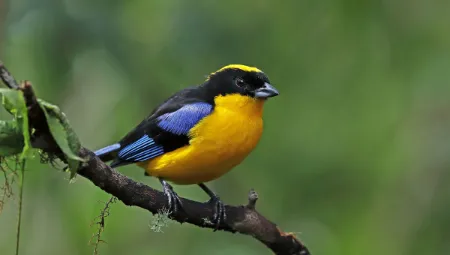
Where To Find This Bird
The Yellow-winged Tanager is found from Veracruz, Mexico to Nicaragua, and from Chiapas, Mexico to Honduras. Also, since October 2010, it has been recorded in Los Chiles, northern Costa Rica.
Short Description of the Bird
It is a neotropical bird of average size. This bird is notable for its yellow patches on dark green wings, which contrast with its dark blue and gray body.
Size of the Bird
- Length: 7 inches
- Weight: 17cm(38-55g)
Diet
Yellow-winged Tanager relishes fruits, insects, and nectar.
How to Identify
It is distinguished by the yellow patches on its dusky green wings, which contrast with its otherwise dark bluish and gray body.
3. Yellow-throated Longclaw

Where to Find This Bird
Found in African grasslands including Tanzania, Kenya, and South Africa. Its natural habitats are dry savanna, subtropical or tropical seasonally wet or flooded lowland grassland, and sandy shores.
Short Description of the Bird
This bird has golden-yellow underparts and eyebrows, and a circular, broad black necklace emphasizing the yellow throat.
Size of the Bird
- Length: 21cm or 8 inches
- Weight: 48-64 g
Diet
Its diet consists of a variety of insects and invertebrates, such as moths, mantids, etc.
How to Identify
The bird resembles a large pipit, has golden-yellow underparts and eyebrows, and a black necklace that highlights its yellow throat.
4. Yellow-crowned Bishop
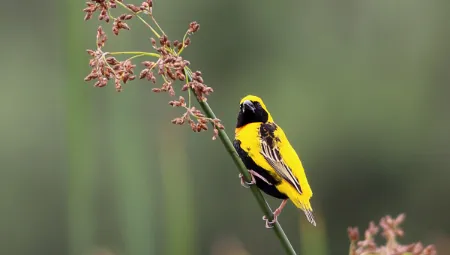
Where to Find This Bird
Yellow-crowned Bishop is found across much of central and Southern Africa. It is now established in Iberia, Jamaica, and Puerto Rico.
Short Description of the Bird
It is highly sexually dimorphic, with males displaying distinctive yellow and black plumage during breeding seasons, contrasting with the female predominantly brown coloration.
Size of the Bird
- Length: 95 to 105mm(3.7-4.1 in)
- Weight: 15g(0.53oz)
Diet
Their food is insects, grains, and seeds.
How to Identify
it is a small bird with a bright yellow crown, black face, throat, chest, and belly in breeding males. Females and nonbreeding males are streaky with white eyebrows and throat.
5. Yellow-breasted Chat
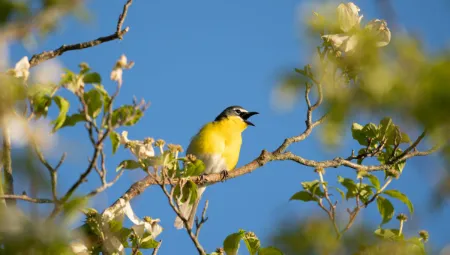
Where To Find This Bird
The Yellow-breasted Chat, native to North America, breeds from Canada to Mexico and mainly migrates to Mexico and Central America for the winter. Some may overwinter in northern coastal areas.
Short Description of the Bird
It is a large songbird and has a bright yellow chest and throat, with olive-green coloring on their backs the tops of their heads, and a white lower belly.
Size of the Bird
- Length: 17 to 19.1 cm(6.7 to 7.5 in)
- Wingspan: 23 to 27 cm (9.1 to 10.6 in)
- Body mass: 20.2 to 33.8g(0.71 to 1.19oz)
Diet
It mainly eats insects and also fruits and berries when available.
How to Identify
It has olive upper parts, a white belly, and a bright-yellow throat and breast.
6. Yellow-rumped Warbler
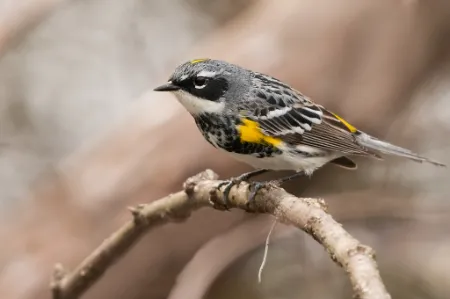
Where To Find This Bird
It is a North American bird species that can be commonly observed all across the continent. During the breeding season, it generally prefers coniferous forests or mixed coniferous-deciduous forests.
In winter, it migrates southwards to North and Central America and can be found inhabiting more open areas such as shrublands.
Short Description of the Bird
It is a small bird characterized by its bright yellow rump, streaky brown and yellow body, and distinctive sharp chips. It has a large head, sturdy bill, and long, narrow tail.
Size of the Bird
- Length: 12 to 15 cm(4.7 to 5.9in)
- Weight: 12g
- Wingspan: 19 to 24 cm(7.5 to 9.4in)
Diet
It primarily feeds on insects and berries.
How to Identify
the bird has unique features, including a yellow rump and black patches on its wings.
7. Yellow- chevroned Parakeet
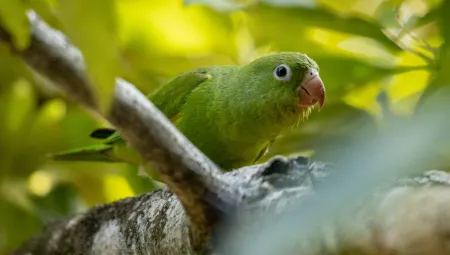
Where To Find This Bird
It is native to South America, particularly south of the Amazon River basin. They inhabit forests, savannas, and open woodlands. Feral populations exist in Miami, Florida, and Los Angeles.
Short Description of the Bird
It is a small parakeet with a long pointed tail, prominent white eyerings, a short pale bill, and a green body distinguished by a yellow border separating the darker flight feathers from the paler inner wings.
Size of the Bird
- Length: 20-25 cm
- Weight: Adult 62g
Diet
Feeds mostly on seeds, nectar, fruits, and blossoms.
How to Identify
It is mostly light green. It has a trailing yellow edge on its wings, visible when the bird is in flight.
8. Yellow-fronted Canary
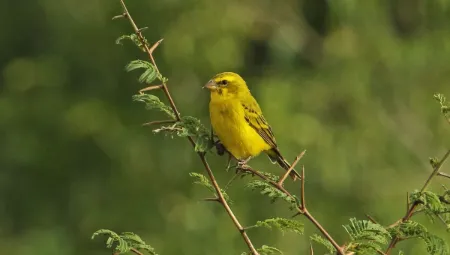
Where To Find This Bird
The yellow-fronted Canary is native to Africa, south of the Sahara Desert. It inhabits open woodland, cultivation, and grasslands. This bird species has also been introduced to the Hawaiian Islands.
Short Description of the Bird
It is a small passerine bird characterized by its bright yellow forehead, throat, and breast, contrasting with its olive-greed back and wings.
Size of the Bird
- Length: 11-13cm
- Weight: 8.5-17g
- Wingspan: 20-30cm
Diet
Its diet primarily flowers, leaves, and insects.
How to Identify
They are bright yellow below with a yellow eyebrow and cheek patch. The upperparts are grayish green with streaks.
9. Yellow-tufted Woodpecker
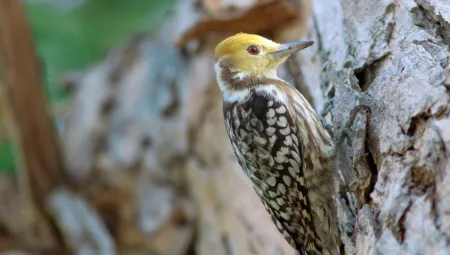
Where To Find This Bird
The Yellow-tufted Woodpecker is native to northern South America, found in countries like Colombia, Venezuela, the Guianas, Brazil, Ecuador, Peru, and Bolivia. It inhabits moist lowland forests and degraded former forests.
Short Description of the Bird
It is a petite bird, mostly black, with a white patch on its lower back. It boasts a distinctive yellow tuft that starts from a yellow ring around its eye. Additionally, it features a vibrant red underside.
Size of the Bird
- Length: Adult 20cm(8 in)
Diet
Its diet is omnivorous, mainly consuming insects, some of which are caught on the wing, and fruits.
How to Identify
It is a loud, colorful bird with bold black and yellow coloration.
Read More: 15 Small Green Birds of Florida (With Pictures)>>>
10. Yellow-bellied Sapsucker
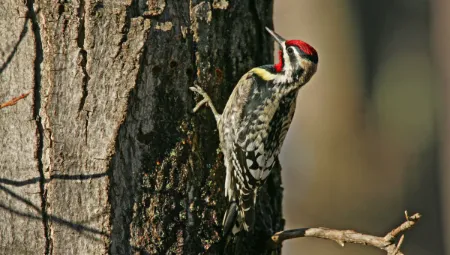
Where To Find This Bird
Found across Canada, eastern Alaska, and the northeastern United States. The eastern United States, West Indies, and Central America serve as winter habitats for these birds.
Short Description of the Bird
It is a medium-sized woodpecker. Recognizable by its barred black-and-white attire, with a red cap and throat.
Size of the Bird
- Length: 19 to 21 cm(7 to 8.5 in)
- Weight: 50.3 g(1.77oz)
- Wingspan: 34 to 40 cm
Diet
Its diet includes insects, tree sap, and fruit.
How to Identify
It has a unique pattern of black, white, and yellow feathers, with a red cap and throat(in males). Their loud mewing calls or stuttered drumming can also be a giveaway. A key distinguishing feature is their vertical white wing patches, which set them apart from similar-looking Downy and Hairy Woodpeckers.
11. Yellow-tailed Black Cockatoo
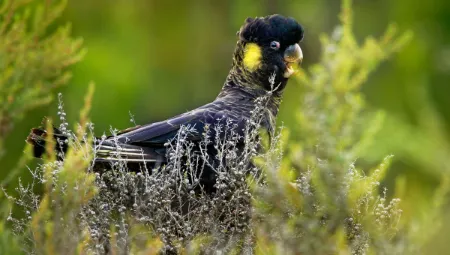
Where To Find This Bird
Yellow-tailed Black Cockatoo is native to the southeast of Australia and can be found in temperate forests across south and central eastern Queensland to southeastern South Australia.
Short Description of the Bird
It is a large cockatoo and has brownish-black plumage, yellow cheek patches, and a yellow tail band. The male has a black beak and pinkish-red eye-rings, while the female has a bone-colored beak and grey eye-rings.
Size of the Bird
- Length: 55-65 cm(22-26in)
- Weight: 750-900g
Diet
It feeds mainly on the seeds of shrubs and trees and, sometimes, ground plants. They also eat the larvae of some wood-boring insects.
How to Identify
It is a loud, distinctive call, and has yellow tail bands.
12. Yellow-shouldered Amazon Parrot
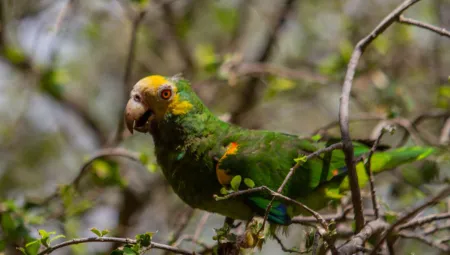
Where To Find This Bird
The Yellow-shouldered Amazon Parrot is native to the arid regions of northern Venezuela, including the Venezuelan islands of Margarita and La Blanquilla, and the islands of Bonaire in the Caribbean Netherlands.
Short Description of the Bird
It is a vibrant bird, mainly green, with a yellow head and shoulder patches, a white forehead, and a red flash on its wings. It also has a bluish tinge on its lower cheek and chin and dark blue tips to its wings.
Size of the Bird
- Length: 33 cm(~13 inches)
- Weight: adult(270g)
Diet
It eats a variety of seeds, nuts, fruits, and flowers. They frequently consume parts of cactus plants, including cactus tops, cactus fruits, and blossoms rich in nectar.
How to Identify
Green with a yellow crown, and often yellow ear coverts and chin, and has dark blue wing tips.
13. Yellow-faced Grassquit
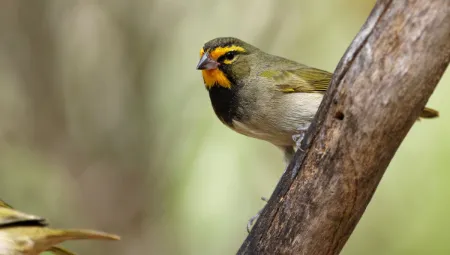
Where To Find This Bird
It is native to Central America, South America, and the Caribbean. It is commonly found in semi-open areas such as roadsides, pastures, and weedy fields, and can also be seen in humid to semi-arid open habitats. Likewise, it is occasionally spotted in southern Texas and Florida.
Short Description of the Bird
It is a small passerine bird, and it is known for its distinctive appearance with a bright yellow throat and supercilia, and a black face and breast.
Size of the Bird
- Length: 10-10.7cm(3.9-4.2 in)
- Weight: 8-10g(0.28-0.35oz)
Diet
Feed mainly on grass seeds, but also takes other seeds, berries, and some insects.
How to Identify
Males have a yellow eyebrow and throat with a black face and breast, while females are olive overall with a faint male face pattern. Both sexes have a sharp, conical gray bill.
14. Yellow-billed Magpie
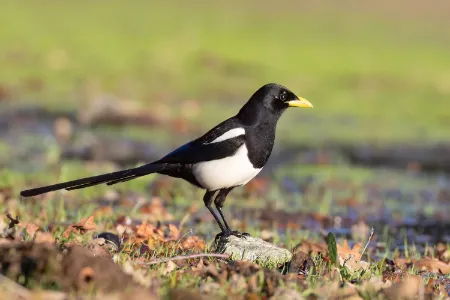
Where To Find This Bird
It also known as the California Magpie, is a bird that is endemic to California. It inhabits California Central Valley and the adjacent chaparral foothill and mountains.
Short description of the Bird
The Yellow-billed Magpie is a large corvid and has a yellow bill and a yellow streak around the eye. Its plumage is a mix of black, white, and shimmering blue-green.
Size of the Bird
- Length: 18-20 inches
- Weight: 150g
- Weigspan: 2 feet
Diet
It primarily eats insects, especially grasshoppers. It also consumes carrion, acorns, and fruits in fall and winter.
How to Identify
It is a riot of black, white, shimmering blue-green, and yellow colors. The bird is easily identifiable by its bright yellow bill.
15. Yellow-crowned Night Heron
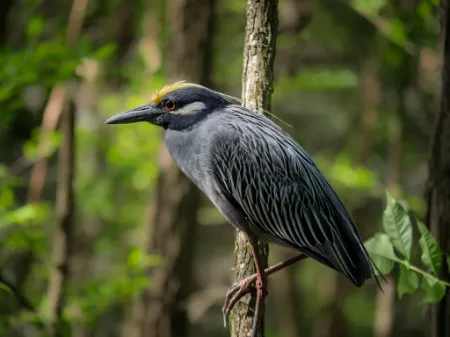
Where To Find This Bird
The Yellow-crowned Night Heron is typically found in wetlands, marshes, swamps, and mangrove forests. They are also known to nest in coastal regions and tend to hunt in shallow water.
Their habitat extends to the central United States, coastal areas in the east of the US, Central America, the north of South America, and around the Galapagos and Caribbean Islands. They can also be found in areas that get flooded regularly.
Short Description of the Bird
It is a stocky wading bird, with females being slightly smaller than males. It has a smooth grey-blue body, a black scaled pattern on the wings, and long yellow to orange legs.
The head is large compared to its body, with a large and heavy bill. The most distinctive feature is its head: black and glossy, with white cheeks and a pale yellow crown.
Size of the Bird
- Length: 55 to 70cm(1 ft 10in-2ft4in)
- Weight: 650 to 850g(1.43-1.87lb)
- Wingspan: 101 to 112 cm(3 ft 4 in-3 ft8 in)
Diet
It is a carnivore and its diet leans heavily on crustaceans. It is especially fond of crabs in coastal areas and crayfish in inland areas. However, it also feeds on fish, amphibians, snails, aquatic insects, and occasionally small snakes or young birds that have fallen from the nest.
How to Identify
It can be identified by its smooth gray-blue colors, sharp black and white face, and long yellow plumes.
Uncovering these 15 yellow birds with black wings is a joy for bird enthusiasts and nature admirers. Each species has its unique behaviors, habitats, and diets, contributing to the rich diversity of our ecosystem. Always stay alert, you might unexpectedly catch a glimpse of a yellow streak in the sky!

